To install gas fireplace logs, start by turning off the gas supply, then remove the old logs and clean the fireplace. Position the new logs according to the manufacturer’s instructions, ensuring proper gas flow and ventilation.
Understanding The Benefits And Types Of Gas Fireplace Logs
Gas fireplace logs are a popular choice among homeowners looking to add warmth and ambiance to their living spaces. They offer a convenient and efficient alternative to traditional wood-burning fireplaces, eliminating the need for chopping and storing firewood. Whether you’re considering a vented or vent-free gas fireplace log, it’s essential to understand the benefits and types available to make an informed decision for your home.
Differentiating between Vented and Vent-Free Gas Fireplace Logs
Before delving into the advantages and disadvantages of each type, it’s crucial to understand the fundamental difference between vented and vent-free gas fireplace logs. Vented gas logs require a chimney or flue system to properly vent the combustion gases, mimicking the look and feel of a traditional wood-burning fire. On the other hand, vent-free gas logs are designed to burn clean and efficiently without the need for venting, making them suitable for spaces without a chimney or flue system. Now, let’s explore the benefits and drawbacks of each type.
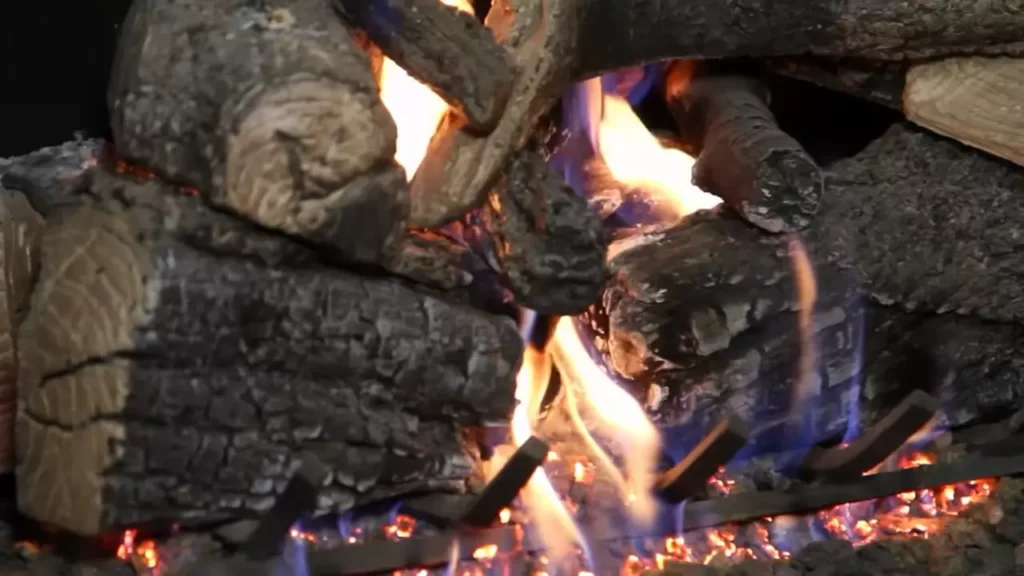
Exploring the Advantages and Disadvantages of each type
Vented Gas Fireplace Logs
Advantages:
- Realistic appearance: Vented gas logs provide a more authentic and natural-looking flame, with detailed log sets that mimic the appearance of real wood logs.
- Warmth and ambiance: The larger, more open flame produced by vented gas logs creates a cozy and inviting atmosphere in your living space.
- Greater heat output: Vented gas logs generate more heat compared to vent-free options, making them an excellent choice for larger rooms or areas that require additional warmth.
Disadvantages:
- Need for ventilation: The primary limitation of vented gas logs is their requirement for a chimney or flue system to ensure proper ventilation. This may result in additional installation costs or limitations in home designs without existing venting infrastructure.
- Less energy-efficient: Vented gas logs are less energy-efficient as a significant portion of the generated heat escapes through the venting system.
Vent-Free Gas Fireplace Logs
Advantages:
- Easy installation: Vent-free gas logs can be an excellent option for homeowners seeking a hassle-free installation process, as they do not require a chimney or flue system.
- Efficient heat production: Vent-free gas logs are designed to maximize heat output within the living space, making them a more energy-efficient option compared to vented gas logs.
- Flexible installation options: Since no venting is required, vent-free gas logs can be installed in various areas of your home, such as bedrooms, basements, or apartments.
Disadvantages:
- Potential for indoor air quality concerns: While modern vent-free gas logs are designed to operate safely, there is a minor possibility of emitting low levels of pollutants. It is crucial to ensure proper ventilation and use caution if considering this option.
- Less realistic flame appearance: Vent-free gas logs produce a smaller and more contained flame, which can be less visually appealing to those seeking a more authentic fireplace experience.
In Conclusion
Understanding the benefits and types of gas fireplace logs allows homeowners to make an informed decision based on their specific needs and preferences. Whether you opt for a vented or vent-free gas log, both offer their advantages and disadvantages. Vented gas logs provide a realistic and visually appealing flame but require a chimney or flue system for proper ventilation. Vent-free gas logs, on the other hand, offer easy installation and energy-efficient heat production, but may raise indoor air quality concerns. Consider these factors carefully to choose the gas fireplace logs that will enhance the comfort and aesthetics of your home.
Measuring And Preparing Your Fireplace For Gas Logs
If you’re looking to add warmth and ambiance to your home, installing gas fireplace logs is a great option. Before you get started, it’s essential to measure and prepare your fireplace properly. By following a few simple steps, you can ensure a safe and efficient installation. In this article, we will guide you through the process of measuring the dimensions of your fireplace for the correct log size, as well as ensuring proper ventilation and clearance requirements. Let’s get started!
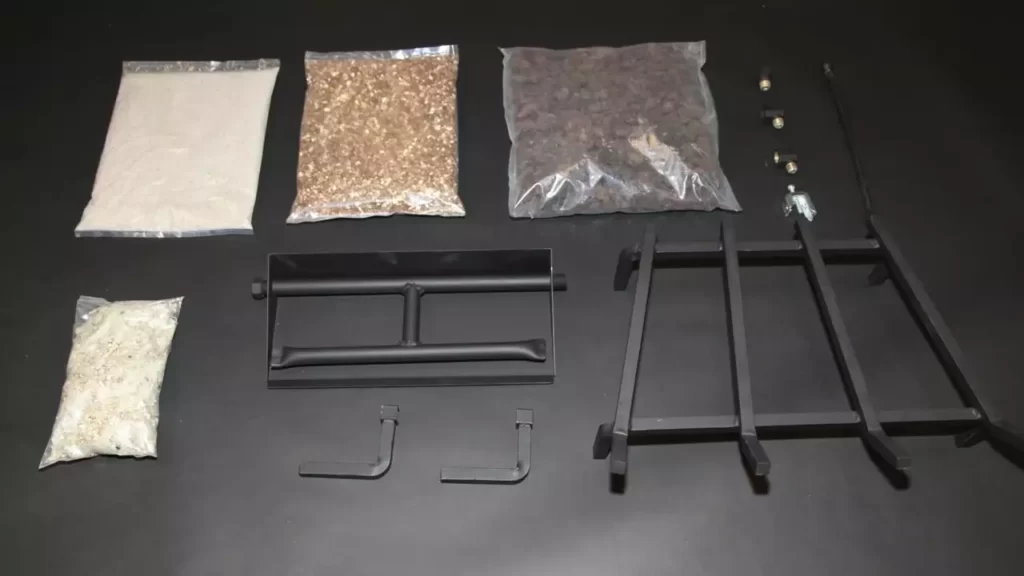
Measuring the dimensions of your fireplace for the correct log size
When it comes to installing gas fireplace logs, the first step is to measure the dimensions of your fireplace to determine the correct log size. This ensures a proper fit and optimal performance. Below is a step-by-step guide on how to measure your fireplace:
- Measure the width:
Using a tape measure, measure the width of the opening of your fireplace from left to right. Be sure to measure at the widest point.
- Measure the height:
Next, measure the height of the opening from top to bottom. Again, measure at the highest point to ensure accuracy.
- Measure the depth:
The depth of your fireplace refers to the distance from the front of the grate to the back wall. Measure this distance to determine the maximum log length that will fit comfortably without obstructing airflow.
Once you have these measurements, you can consult the manufacturer’s guidelines or speak to a professional to determine the appropriate log size for your fireplace.
Ensuring proper ventilation and clearance requirements
In addition to measuring the dimensions of your fireplace, it’s crucial to ensure proper ventilation and clearance requirements. This promotes safe and efficient operation. Here are a few key factors to consider:
- Check your fireplace damper:
Make sure your damper is in good working condition and easily operable. The damper is essential for controlling the amount of air flowing through the fireplace.
- Verify clearance requirements:
Check the manufacturer’s guidelines to determine the required clearance around the fireplace. This includes clearance from nearby combustible materials such as walls, furniture, and curtains.
- Ensure proper ventilation:
Adequate ventilation is crucial to prevent the buildup of carbon monoxide and other harmful gases. If your fireplace doesn’t have proper ventilation, it may be necessary to install vents or consult a professional for guidance.
By taking the time to measure the dimensions of your fireplace and ensuring proper ventilation and clearance requirements, you can enjoy the beauty and warmth of gas fireplace logs with peace of mind.
Gathering The Necessary Tools And Materials
Before you can begin the installation process for your gas fireplace logs, it’s essential to gather all the necessary tools and materials. This will ensure a smooth and efficient installation, saving you time and frustration. In this section, we’ll discuss the tools needed for installation and how to choose the right logs and accessories for your fireplace.
Identifying the tools needed for installation
When it comes to installing gas fireplace logs, having the right tools can make a world of difference. Before you start the installation process, gather the following tools:
- Socket wrench
- Phillips screwdriver
- Flathead screwdriver
- Adjustable wrench
- Nut driver
- Tape measure
- Drill
- Hole saw
Having these tools on hand will ensure that you’re prepared for any challenges that may arise during the installation process.
Choosing the right logs and accessories for your fireplace
When it comes to gas fireplace logs, choosing the right ones is crucial for both aesthetics and functionality. Here’s what you need to consider:
| Factor | Considerations |
|---|---|
| Size | Measure the dimensions of your fireplace to determine the appropriate log size. |
| Style | Select a log style that complements your home’s decor and matches your personal taste. |
| Material | Choose logs made from durable materials such as ceramic or refractory cement for longevity. |
| Accessories | Consider accessories like log holders, ember beds, and decorative rocks to enhance the overall look of your fireplace. |
By carefully considering these factors and choosing high-quality logs and accessories, you can transform your fireplace into a stunning focal point in your home.
Now that you have gathered all the necessary tools and have an understanding of how to choose the right logs and accessories, you are ready to move on to the next step: preparing your fireplace for installation.
Preparing The Gas Line And Connections
Shutting off the gas supply and disconnecting the existing gas line (if applicable)
Before installing your gas fireplace logs, it is crucial to shut off the gas supply and disconnect any existing gas line. This step ensures your safety and avoids any potential gas leaks or accidents. Follow the steps below to do this:
- Locate the gas shut-off valve: It is usually found near the gas meter or where the gas line enters your home. Make sure you know the exact location of the valve beforehand.
- Turn off the gas supply: Using a wrench, turn the valve clockwise until it is fully closed. This action stops the flow of gas to your fireplace and ensures a safe working environment.
- Disconnect the existing gas line (if applicable): If you have an existing gas line connected to your fireplace, you’ll need to disconnect it. Use a wrench to loosen the fitting connecting the gas line to the fireplace. Once loosened, carefully remove the line from the fireplace.
Inspecting and cleaning the gas line for any debris or damage
Inspecting and cleaning the gas line is an important step in preparing the gas line and connections for your gas fireplace logs installation. Follow the steps below to ensure your gas line is free from any debris or damage:
- Visual inspection: Carefully examine the gas line for any signs of corrosion, damage or wear. Look for any cracks, leaks, or loose fittings.
- Cleaning the gas line: Using a soft-bristle brush or a clean cloth, gently wipe the exterior of the gas line to remove any dirt, dust, or debris.
- Checking for debris: Inspect the gas line openings for any debris or blockages. Use a flashlight and ensure there are no spider webs, dust, or other obstructions that could affect the gas flow.
Regular inspection and cleaning of the gas line are essential for maintaining the safety and efficiency of your gas fireplace logs. If you notice any significant damage or suspect a gas leak, it is crucial to seek professional assistance before continuing with the installation.
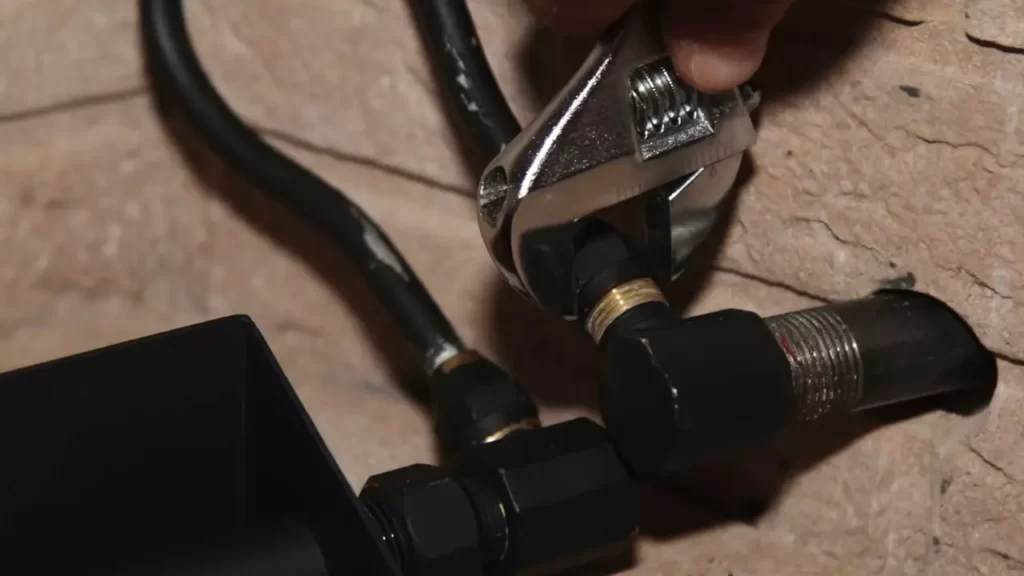
Installing The Gas Logs And Burner
When it comes to installing gas fireplace logs, one of the crucial steps is positioning the logs according to the manufacturer’s instructions. These instructions will guide you on how to arrange the logs to achieve a natural-looking flame pattern and ensure proper airflow for optimal performance. Additionally, connecting the burner and securing it in place is essential to prevent any potential hazards and ensure safe operation of your gas fireplace. In this section, we will delve into the details of positioning the logs and securely connecting the burner, providing you with a step-by-step guide for a successful installation.
Positioning the logs according to the manufacturer’s instructions
The first step in installing gas logs is adhering to the manufacturer’s instructions for log placement. Each set of logs may have specific requirements for positioning them to achieve a realistic flame appearance. Some logs may have distinct shapes and sizes, while others may have specific designated spots or notches that need to be followed. Refer to the instruction manual that came with your gas logs to ensure you are arranging them correctly.
Follow these guidelines to properly position the gas logs:
- Begin by placing the larger, base logs on the bottom of the fireplace, ensuring they are securely positioned.
- Next, arrange the smaller logs on top of the base logs, ensuring a balanced and visually appealing configuration.
- Refer to the instruction manual to determine the spacing between the logs. Proper spacing is crucial for adequate air circulation and a lifelike flame pattern.
- Take caution not to obstruct any ventilation holes or openings in your fireplace when positioning the logs.
Connecting the burner and securing it in place
Once you have positioned the gas logs according to the manufacturer’s instructions, it’s time to connect the burner and ensure it is securely in place. Follow these steps:
- Locate the designated area for connecting the burner in your fireplace.
- Attach the gas supply line to the burner, ensuring a tight and secure connection.
- Use a wrench or pliers to tighten any fittings, making sure they are leak-proof.
- Secure the burner in place inside the fireplace, ensuring it is stable and properly aligned with the placed logs.
- Ensure that the burner is not touching or interfering with any other components of the fireplace.
By following these steps and adhering to the manufacturer’s instructions, you can successfully position the gas logs and connect the burner, setting the stage for an enjoyable and efficient gas fireplace experience.
Testing The Ventilation And Gas Pressure
Reconnecting the Gas Line and Checking for Any Leaks
With the ventilation and gas pressure properly installed, it’s time to reconnect the gas line and ensure there are no leaks. This step is crucial for the safe operation of your gas fireplace.
Before reconnecting the gas line, make sure the gas supply valve is turned off. This will prevent any gas from leaking while you work. Once the valve is closed, you can proceed with the following steps:
- Inspect the gas line and fittings for any damage or wear. If you notice any issues, it’s essential to replace the damaged parts before proceeding.
- Apply a small amount of gas-rated pipe joint compound or Teflon tape to the threads of the gas line fittings. This will help create a secure and leak-free connection.
- Gently tighten the fittings using an adjustable wrench or pipe wrench. Be careful not to overtighten, as this can cause damage to the fittings.
- Once the gas line is securely connected, it’s time to check for any leaks. To do this, mix a solution of dish soap and water in a spray bottle.
- Spray the solution onto the gas line connections and fittings. If you see any bubbles forming, it indicates a leak. In this case, you should immediately turn off the gas supply valve and seek the assistance of a professional.
Ensuring Proper Airflow and Ventilation for Safe Operation
Proper airflow and ventilation are crucial for the safe operation of your gas fireplace. Without adequate ventilation, harmful gases like carbon monoxide can build up in your home. Therefore, it’s essential to follow these steps to ensure proper airflow:
- Check the venting system for any blockages or obstructions. Clear away any debris, dirt, or other materials that could restrict the airflow.
- Inspect the fireplace’s vent cap to ensure it is in good condition and properly secured. If you notice any damage or loose fittings, it’s crucial to address them before using the fireplace.
- Test the draft by lighting a match near the fireplace opening. If the flame is pulled towards the opening, it indicates proper airflow. However, if it is pushed away or remains steady, there may be an issue with the ventilation system.
- Consider installing a carbon monoxide detector near the fireplace and in other areas of your home. This will provide an additional layer of safety by alerting you to any potential carbon monoxide buildup.
By following these steps and ensuring proper airflow and ventilation, you can enjoy the warmth and ambiance of your gas fireplace with peace of mind knowing that it is operating safely.
Understanding The Safety Considerations Of Vent-Free Logs
Familiarizing yourself with the safety guidelines and requirements
When installing gas fireplace logs, it is crucial to familiarize yourself with the safety guidelines and requirements to ensure a safe and efficient operation. Vent-free logs offer a convenient and cost-effective alternative to traditional vented logs. However, it is important to understand the specific safety considerations associated with vent-free logs.
- Read the manufacturer’s instructions: Before starting the installation process, carefully read the manufacturer’s instructions that come with your vent-free gas logs. These instructions provide detailed information on how to safely install and operate the logs, ensuring your safety and compliance with the manufacturer’s guidelines.
- Check local building codes: Each municipality may have specific building codes relating to the installation of gas fireplace logs. Before proceeding with the installation, check with your local authorities or consult a professional to ensure compliance with these codes. This step guarantees that the installation meets the necessary safety standards.
- Inspect the gas supply: Before installing vent-free logs, it is vital to inspect the gas supply connections to identify any leaks or damage. If you notice any issues, contact a qualified professional to address the problem before proceeding.
By following these safety guidelines and requirements, you can ensure a safe and compliant installation process for your vent-free gas logs.
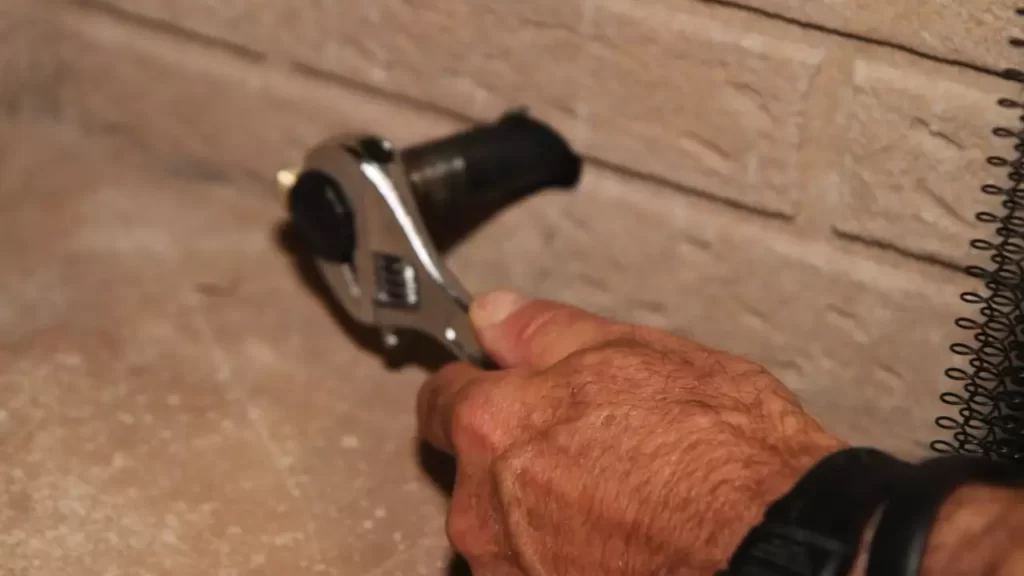
Addressing concerns regarding indoor air quality and ventilation
One significant concern associated with vent-free gas logs is the impact on indoor air quality and the need for proper ventilation. While vented logs release the combustion byproducts outside through a chimney or vent, vent-free logs are designed to operate without requiring a venting system. To address these concerns and ensure your indoor air quality remains at optimal levels, consider the following:
- Proper room size: Make sure the room where the vent-free logs will be installed is of the appropriate size for the logs you are using. Vent-free logs have specific guidelines concerning the maximum square footage they can effectively heat. Ensuring the room is within the recommended size range helps maintain good air quality.
- Regular maintenance: It is essential to perform regular maintenance on your vent-free gas logs to ensure optimal performance. Follow the manufacturer’s instructions on cleaning and inspecting the logs for any signs of soot buildup or malfunctioning parts. Routine maintenance allows for efficient combustion and reduces the risk of indoor air quality issues.
- Provide adequate ventilation: Although vent-free logs are designed to operate without vents, it is still beneficial to provide some ventilation in the room. Opening a window or using a ceiling fan can help promote airflow and maintain fresh air circulation, preventing any potential buildup of combustion byproducts.
Addressing indoor air quality concerns and ensuring proper ventilation are crucial steps in maintaining a safe and comfortable environment when using vent-free gas logs.
Measuring And Preparing Your Fireplace For Vent-Free Logs
Installing The Vent-Free Gas Logs
Installing vent-free gas logs in your gas fireplace can provide a cozy and realistic fire without the hassle of wood burning. However, it’s important to follow the manufacturer’s instructions when it comes to placing the logs in the desired arrangement and connecting the necessary gas lines. In this section, we will discuss the steps involved in installing vent-free gas logs, including placing the logs and securing them in place.
Placing the logs in the desired arrangement according to the manufacturer’s instructions
Before you begin installing vent-free gas logs, carefully read the manufacturer’s instructions that come with the logs. These instructions will provide specific guidelines on how to arrange the logs in your fireplace for optimal performance and safety.
To start, remove any existing logs or debris from the fireplace. Then, inspect the vent-free gas logs to identify the specific arrangement recommended by the manufacturer. Some logs may have notches or grooves that indicate their proper position.
Once you have identified the desired arrangement, carefully place the logs in the fireplace according to the manufacturer’s instructions. Make sure each log is securely positioned and has enough space between them for the flames to circulate.
Connecting the necessary gas lines and securing the logs in place
After placing the logs, it’s time to connect the necessary gas lines and secure the logs in place. Start by turning off the gas supply to the fireplace and make sure all pilot lights are extinguished.
Next, locate the gas line connection on the logs. This is usually located at the base of the logs or on the side. Carefully connect the gas line to the log, ensuring a tight fit. Use a wrench to secure the connection, but be careful not to overtighten.
Once the gas line is securely connected, double-check all connections to ensure there are no leaks. You can do this by applying a solution of soapy water to the connections and watching for any bubbles. If you see bubbles, there may be a leak, and you should immediately discontinue installation and consult a professional.
Finally, secure the logs in place according to the manufacturer’s instructions. This may involve attaching retaining brackets or other securing mechanisms. Make sure these mechanisms are firmly in place to prevent any movement of the logs during operation.
Installing vent-free gas logs in your gas fireplace can be a great way to enjoy the warmth and ambiance of a fire without the hassle of traditional wood burning. By following the manufacturer’s instructions and taking the necessary precautions, you can safely and effectively install vent-free gas logs in your fireplace.
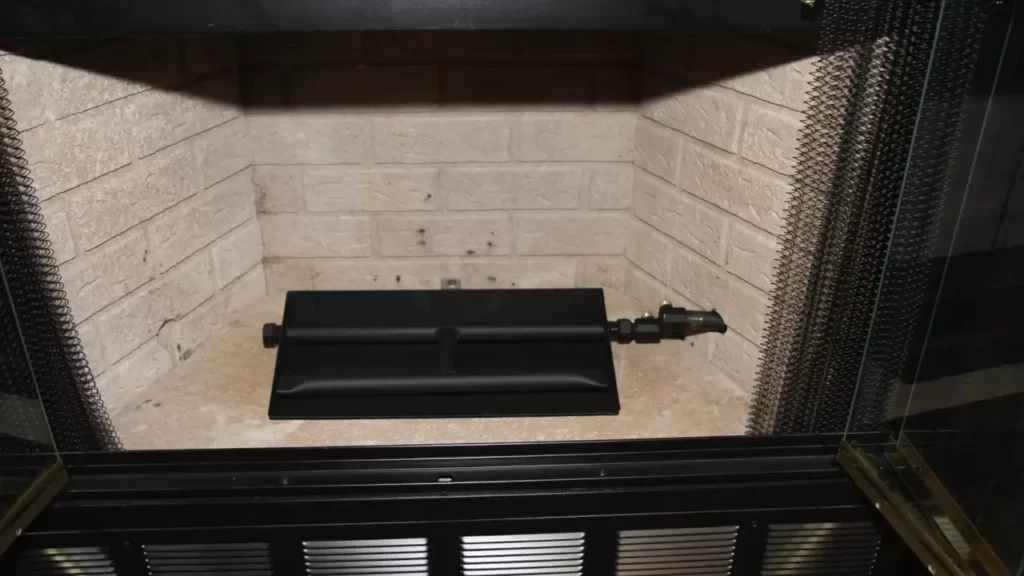
Testing The Gas Pressure And Flame Performance
Ensuring the proper gas pressure and flame appearance
When installing gas fireplace logs, it is crucial to test the gas pressure and flame performance to ensure a safe and efficient operation of your fireplace. Proper gas pressure ensures that the flames burn evenly and the logs produce a realistic and attractive flame pattern.
Testing the gas pressure
Before lighting the fireplace, it is essential to check the gas pressure to make sure it meets the manufacturer’s specifications. Here are the steps to test the gas pressure:
- Locate the gas valve on your fireplace and turn it off.
- Connect a gas pressure gauge to the gas valve. Make sure it is securely attached.
- Slowly turn on the gas valve and observe the gauge. The pressure reading should fall within the recommended range specified by the manufacturer. If the pressure is too low or too high, it may affect the flame performance and can be a safety hazard.
- If the pressure is not within the recommended range, it is essential to consult a professional to adjust the pressure regulator or the gas supply.
Adjusting the logs for an even and realistic flame pattern
Once the gas pressure is tested and adjusted if necessary, the next step is to ensure that the logs are properly arranged for an even and realistic flame pattern. Follow these steps to adjust the logs:
- Refer to the installation manual provided by the manufacturer for specific instructions on log placement.
- Start by placing the largest logs at the back of the fireplace. These logs typically represent the base of the fire.
- Arrange the smaller logs in front of the larger logs, staggering them to create a natural-looking flame appearance.
- Ensure that the logs are placed securely on the burner and do not obstruct the gas flow.
- Take a step back and assess the overall appearance of the logs. Make any necessary adjustments to achieve a balanced and visually appealing flame pattern.
By testing the gas pressure and adjusting the logs for an even and realistic flame pattern, you can enjoy a beautiful and efficient gas fireplace that adds warmth and ambiance to your space.
Identifying Common Issues With Gas Fireplace Logs
Gas fireplace logs offer a convenient and cozy alternative to traditional wood-burning fireplaces. However, like any other appliance, gas fireplace logs can encounter issues from time to time. Being able to identify and troubleshoot these issues can help ensure that your gas fireplace operates safely and efficiently. In this section, we will explore two common issues with gas fireplace logs: pilot light failure and uneven flame distribution. We will also address the important matter of potential gas leaks or ventilation problems.
Troubleshooting Issues such as Pilot Light Failure or Uneven Flame Distribution
When it comes to gas fireplace logs, having a reliable pilot light is crucial. The pilot light serves as an ignition source for the gas, allowing the flames to start and continue burning. If your pilot light fails to ignite or goes out frequently, it can be due to a variety of reasons:
- Check the gas valve: Ensure that the gas valve supplying fuel to the fireplace logs is fully open. Sometimes, a partially closed valve can prevent the pilot light from igniting.
- Inspect the thermocouple: The thermocouple is a safety device that helps maintain the flow of gas to the pilot light. If it becomes dirty or malfunctions, it can cause the pilot light to go out. Gently clean the thermocouple or consider replacing it if necessary.
- Clear any obstructions: Dirt, dust, or debris buildup in and around the pilot light can obstruct the flow of gas and prevent it from igniting properly. Use a soft brush or compressed air to remove any obstructions.
In addition to pilot light issues, you may also encounter uneven flame distribution in your gas fireplace logs. This can lead to an unbalanced appearance and potentially inefficient performance. Here are a few steps to troubleshoot this problem:
- Check for clogs: Over time, the gas lines supplying the fireplace logs can accumulate dust, debris, or spider webs. Inspect the gas lines and clean them if necessary.
- Adjust the air shutter: The air shutter controls the amount of air mixed with the gas, affecting the flame’s shape and size. Gradually adjust the air shutter to achieve a more uniform flame distribution.
- Inspect the gas orifices: Gas orifices distribute the gas to each burner. If they become clogged or damaged, it can result in uneven flame distribution. Clean or replace the gas orifices as needed.
Addressing Potential Gas Leaks or Ventilation Problems
Gas leaks and ventilation problems are serious concerns when it comes to gas fireplace logs. A gas leak can pose a significant safety risk, while inadequate ventilation can lead to the accumulation of harmful gases inside your home. Here are some steps to address these potential issues:
- Inspect for gas leaks: Check for the smell of gas near the fireplace or any audible hissing sounds. If you suspect a gas leak, immediately shut off the gas supply and contact a professional to safely identify and repair the leak.
- Ensure proper ventilation: Gas fireplace logs require adequate ventilation to ensure proper combustion and prevent the buildup of carbon monoxide. Make sure the chimney or venting system is clean and free from obstructions. Regularly inspect and maintain the venting system to ensure it functions effectively.
- Install carbon monoxide detectors: Carbon monoxide is an odorless and potentially deadly gas. To enhance safety, install carbon monoxide detectors near your gas fireplace and other relevant areas. Regularly test and replace batteries to ensure they are functioning properly.
By understanding and addressing these common issues with gas fireplace logs, you can enjoy the warmth and ambiance of your fireplace with peace of mind. Remember to always prioritize safety and consult a professional if you encounter complex issues or feel uncomfortable performing troubleshooting tasks.
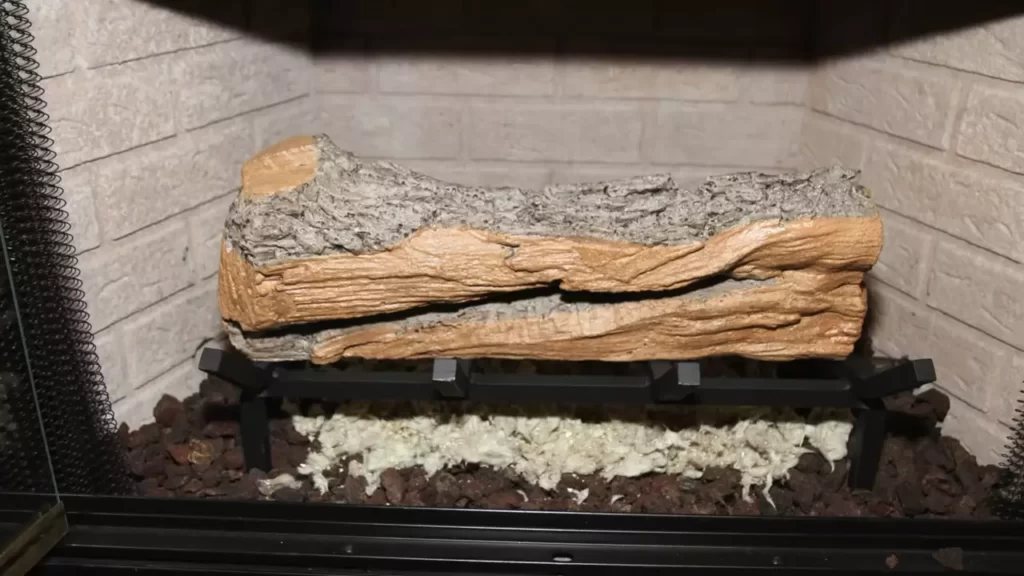
Regular Maintenance And Cleaning
Performing routine cleaning and inspection of the logs and burner
Regular maintenance and cleaning of your gas fireplace logs is essential to ensure optimal performance and extend their lifespan. By performing routine cleaning and inspection, you can prevent any buildup of debris, dust, or soot that could affect the functionality of your logs and burner.
Here are some steps you can follow:
- Turn off the gas supply: Before you begin any cleaning or inspection work, make sure to turn off the gas supply to the fireplace. This is crucial to ensure your safety and prevent any accidents.
- Remove the logs: Carefully remove the gas logs from the fireplace, making sure not to damage them in the process. Inspect them for any signs of wear or damage, such as cracks or loose connections.
- Clean the logs: Use a soft brush or cloth to gently remove any dust or debris from the surface of the logs. Avoid using any harsh cleaning agents, as they could damage the logs or affect their appearance.
If there is excessive soot buildup, you may use a mild soap solution to clean them. Rinse thoroughly and let them dry completely before placing them back in the fireplace. - Inspect the burner: Take a close look at the burner to ensure there are no blockages or obstructions. Use a small brush or compressed air to remove any debris that may be trapped in the burner. This will help maintain proper gas flow and prevent any issues with ignition or flame quality.
- Check for gas leaks: It’s important to regularly check for gas leaks to ensure the safety of you and your family. Apply a solution of soapy water to the gas connections and watch for any bubbles. If you notice any bubbles forming, it indicates a gas leak, and you should contact a professional for repairs.
Checking and replacing the necessary components for optimal performance
To ensure your gas fireplace logs continue to perform at their best, it’s essential to regularly check and replace any components that may be worn out or not functioning properly.
Here are some components that may require checking or replacement:
- Thermocouple: The thermocouple is responsible for sensing the heat from the pilot flame and allowing the gas valve to stay open. Over time, it may become weak or corroded, preventing the gas flow. Inspect it for any signs of damage or wear and replace if necessary.
- Thermopile: The thermopile generates electricity to power the gas valve and other electrical components. Check the connections to ensure they are secure and clean any debris or corrosion that may be present. If the thermopile is not producing enough power, it may need to be replaced.
- Gas valve: The gas valve controls the flow of gas to the fireplace. If you notice any issues with the flame quality or if the gas flow is inconsistent, the gas valve may need to be inspected or replaced by a professional.
- Ignition system: The ignition system, such as a pilot light or electronic ignition, is responsible for igniting the gas and starting the fire. Make sure the pilot light is lit and that the electrodes or igniter are clean and in good condition. Replace any faulty components to ensure proper ignition.
By regularly performing maintenance and cleaning tasks, you can prolong the lifespan of your gas fireplace logs and ensure they operate safely and efficiently. Remember, if you are unsure about any maintenance or repair tasks, it’s always best to consult a professional.
Enhancing The Ambience And Safety Of Your Gas Fireplace
Enhancing the Ambience and Safety of your Gas Fireplace
Adding decorative accessories and enhancements to improve the visual appeal
When it comes to your gas fireplace, why settle for a plain and unremarkable look when you can easily enhance its visual appeal? Adding decorative accessories and enhancements not only elevates the overall ambiance of your living space but also creates a cozy and inviting atmosphere. With a few simple additions, you can transform your gas fireplace into a stunning focal point in your home.
| Accessories | Enhancements |
|---|---|
|
|
Implementing safety precautions such as carbon monoxide detectors and fire extinguishers
While enhancing the aesthetics of your gas fireplace is important, prioritizing safety should be your top concern. The warmth and comfort of a gas fireplace can be enjoyed responsibly by implementing essential safety precautions. Ensure your peace of mind by adhering to the following practices:
- Install carbon monoxide detectors near your gas fireplace to safeguard against potential leaks.
- Place fire extinguishers within reach, providing quick access in case of emergencies.
- Regularly inspect and maintain your gas fireplace to detect any issues or malfunctions.
- Follow the manufacturer’s instructions for proper usage and installation.
Frequently Asked Questions Of How To Install Gas Fireplace Logs
Can You Install Your Own Gas Logs?
Yes, you can install your own gas logs as long as you follow the instructions provided. However, it is recommended to hire a professional for safety and proper installation.
How Do You Hook Up Gas Logs To A Fireplace?
To hook up gas logs to a fireplace, first, ensure the fireplace is compatible with gas logs. Connect the gas supply line to the valve at the base of the fireplace. Install the gas logs according to the manufacturer’s instructions, making sure the logs are arranged properly.
Test for gas leaks and ignite the logs as directed. Enjoy the warmth and ambiance of your gas log fireplace.
Can You Install Gas Logs In the Existing Fireplace?
Yes, you can install gas logs in an existing fireplace. This allows you to enjoy a convenient and efficient alternative to wood burning. Consult a professional to ensure proper installation and to determine if your fireplace is compatible with gas logs.
Do Gas Logs In A Fireplace Need To Be Vented?
Gas logs in a fireplace do not need to be vented as they are designed to emit low levels of carbon monoxide. However, it is recommended to have a vented gas log set if your fireplace does not have proper ventilation.
Venting helps to remove any harmful gases from the home.
Conclusion
Installing gas fireplace logs can be a great way to add warmth and ambiance to your home. By following the steps outlined in this blog post, you can ensure a safe and successful installation process. Remember to always prioritize safety and consult professional help if needed.
Now, you can sit back, relax, and enjoy the cozy comfort of your newly installed gas fireplace logs. Happy heating!
